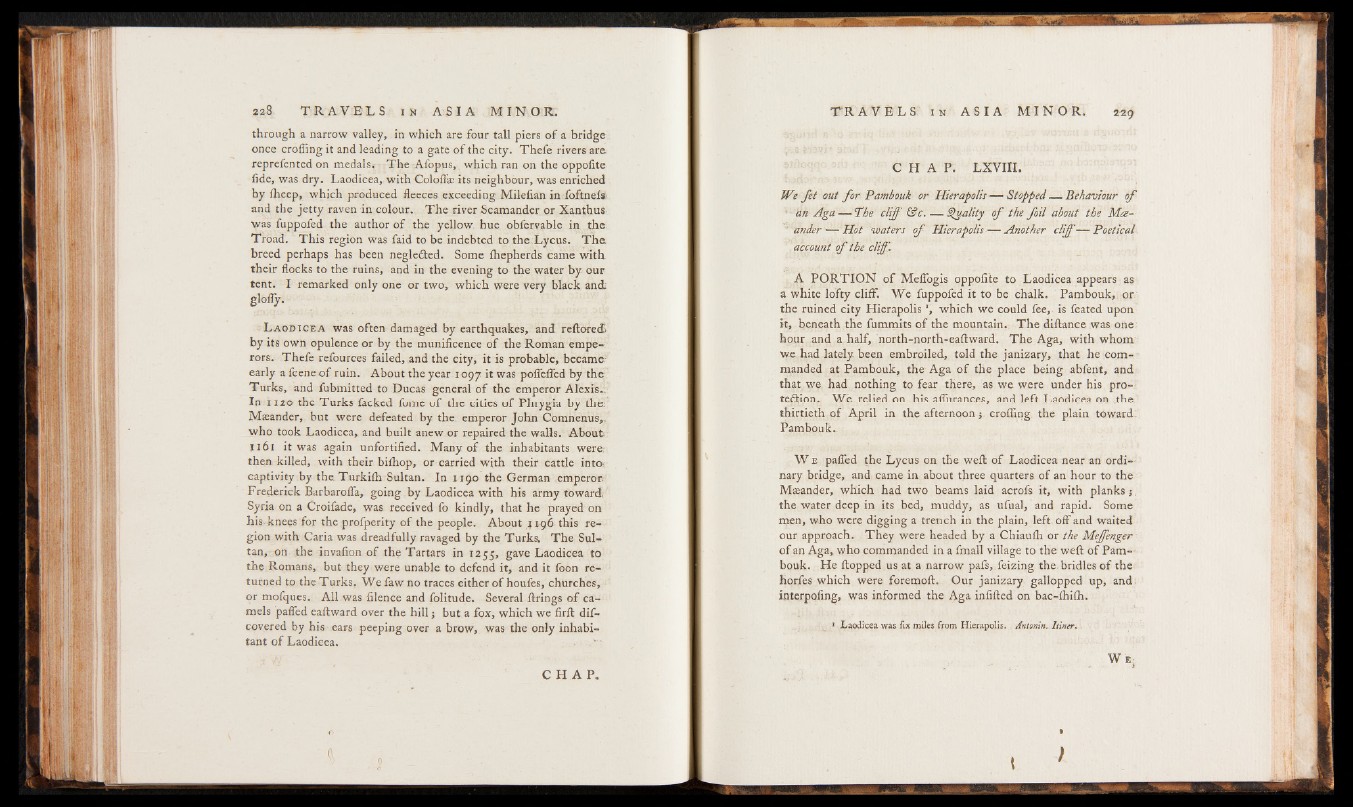
through a narrow valley, in which are four tall piers of a bridge
once eroding it and leading to a gate of the city. Thefe rivers are
reprefented on medals. The Afopus, which ran on the oppofite
fide, was dry. Laodicea, with Coloffas its neighbour, was enriched
hy iiieep, which produced fleeces exceeding Milefian in foftnels
and the jetty raven in colour. The river Scamander or Xanthus
was fuppofed the author of the yellow hue obfervable in the
Troad. This region was faid to be indebted to the Lycus. The
breed perhaps has been negledted. Some fhepherds came with
their flocks to the ruins, and in the evening to the water by our
tent. I remarked only one or two, which were very black and;
glofly.
L a o d ic e a was often damaged by earthquakes, and refloredi
by its own opulence or by the munificence of the Roman emperors.
Thefe refources failed, and the city, it is probable, became-
early a feene o f ruin. About the year 1097 it was poffeffed by the
Turks, and fubmitted to Ducas general of the emperor Alexis-
In 1120 the Turks facked fome of the cities of Phrygia by the:
Maeander, but were defeated by the emperor John Comnenus,,
who took Laodicea, and built anew or repaired the walls. About
1161 it was again unfortified. Many of the inhabitants were:
then killed, with their bilhop, or carried with their cattle into:
captivity by the Turkifh Sultan. In 1190 (die German emperor.
Frederick Barbarofla, going by Laodicea with his army toward,
Syria on a Croifade, was received fo kindly, that he prayed on
his-knees for the profperity of the people. Aboutjf 196 this region
with Caria was dreadfully ravaged by the Turks. The Sultan,
on the invafion of the Tartars in 1255, gave Laodicea to
the Romans, but they were unable to defend it, and it foon returned
to the Turks, Wefawno traces either of houfes, churches,
or mofques. All was filence and folitude. Several firings of camels
pafled eaftward over the hill; but a fox, which we firlt discovered
by his ears peeping over a brow, was the only inhabitant
of Laodicea.
C H A P . L XVIII.
We fe t out fo r Pambouk or Hierapolis —• Stopped — Behaviour of
■ an Aga— The cliff &c. — Quality o f the fo il about the Mce-
' andei----Hot waters o f Hierapolis — Another cliff— Poetical
account o f the cliff.
A PORTION of Meffogis oppofite to Laodicea appears as
a white lofty cliff. We fuppofed it to be chalk. Pambouk, or
the ruined city Hierapolis ', which we could fee, is feated upon
it, beneath the fummits of the mountain. The diftance was one
hour and a half, north-north-eaftward. The Aga, with whom
we had lately been embroiled, told the janizary, that he commanded
at Pambouk, the Aga of the place being abfent, and
that we had nothing to fear there, as we were under his protection.
We relied on his aflurances, and left Laodicea on the
thirtieth of April in the afternoon; eroding the plain toward;
Pambouk-
W e pafled the Lycus on the weft of Laodicea near an ordinary
bridge, and came in about three quarters of an hour to the
Meander, which had two beams laid acrofs it, with planks j,
the water deep in its bed, muddy, as ufual, and rapid. Some
men, who were digging a trench in the plain, left off and waited
our approach. They were headed by a Chiaufli or the Meffenger
of an Aga, who commanded in a fmall village to the weft of Pam--
bouk. He flopped us at a narrow pafs,.feizing the. bridles of the
horfes which were foremoft. Our janizary gallopped up, and
interpofing, was informed the Aga infilled on bac-lhilh.
1 Laodicea was fix miles from Hierapolis. Antonin. Itiner.
• - .-v- ... W• e*
»
t /